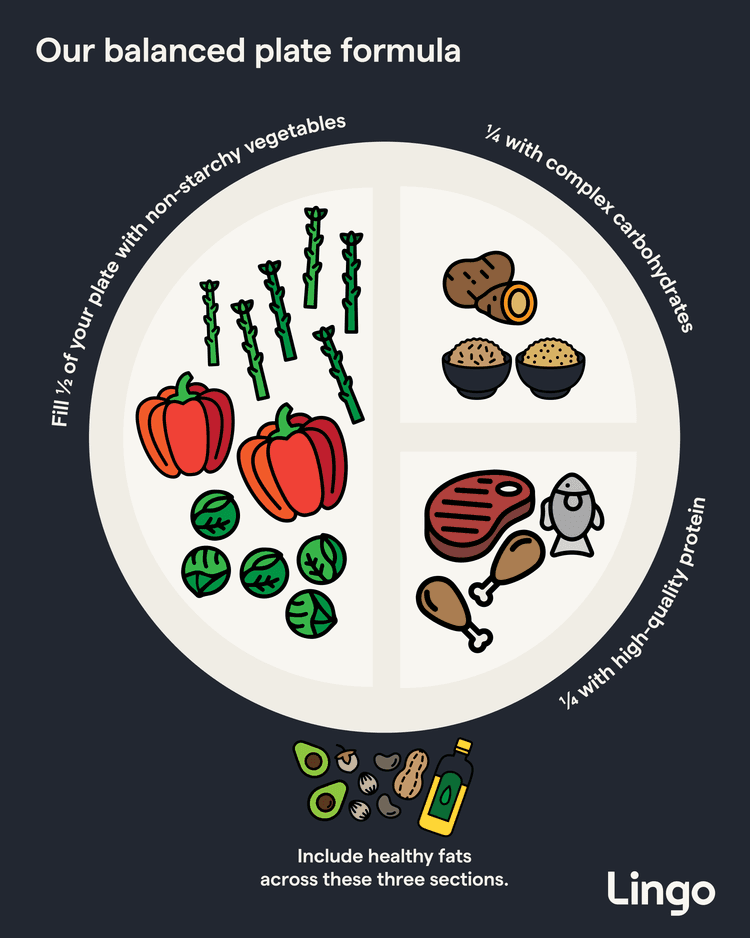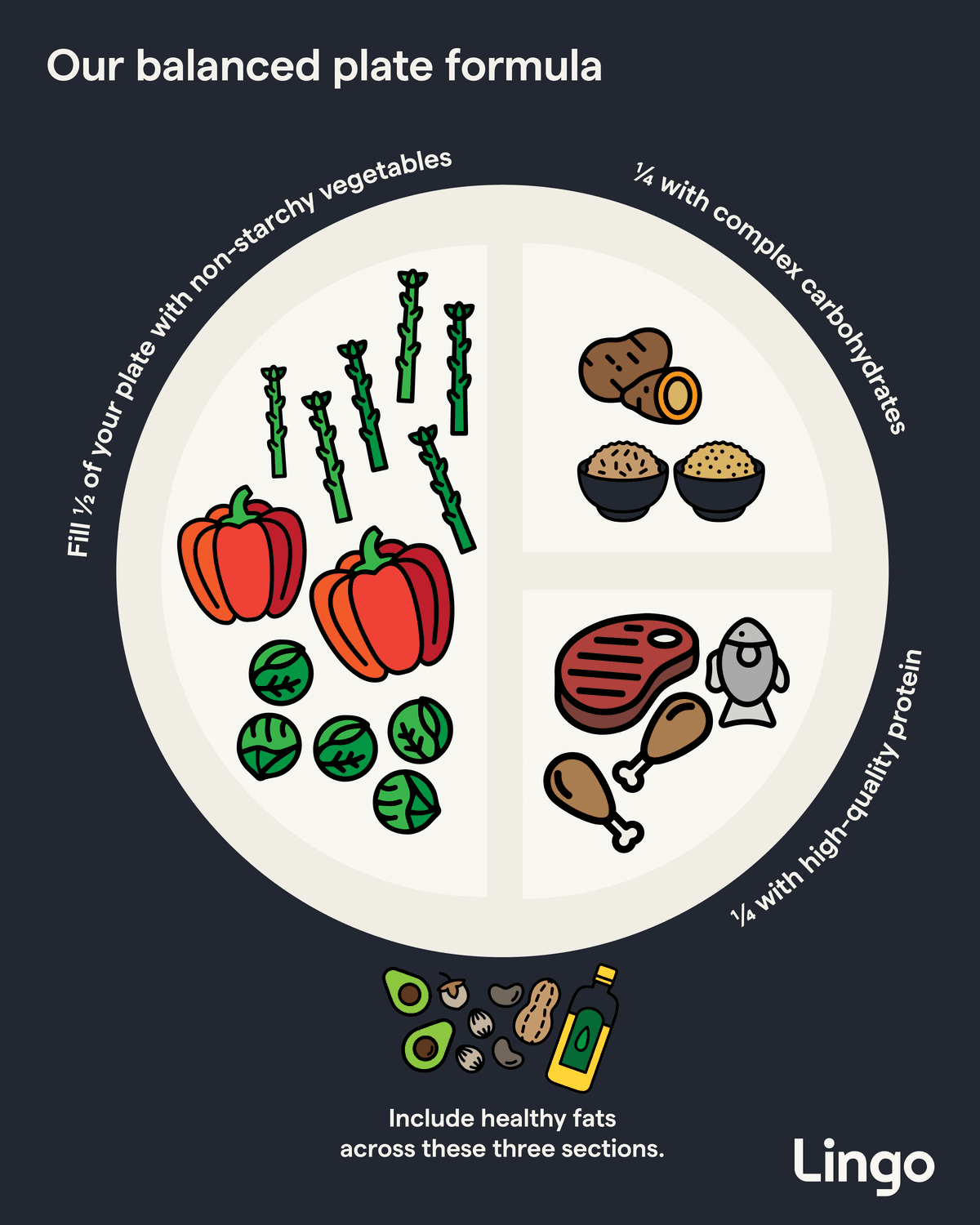What is good nutrition? Guidance from our experts for healthy eating
Nutrition plays an important role in your long-term health. Learn how to follow a healthy, balanced diet with advice from our nutrition experts.
Andrea Givens, MS, RD, CSSD,
Medical Affairs
Sarah Koenck, MS, RD,
Medical Affairs
Published:
January 27, 2025
Updated:
October 01, 2025
Read time:
8 minutes

Your nutrition choices now play a vital role in both your short-term and your long-term health.
Building a balanced plate for your meals is about considering food proportions of carbs, proteins, and vegetables, as well as pairings and healthy fats.
There are many day-to-day actions you can begin practicing to improve your eating habits and make healthier choices.
Start Lingo today for just $49
Learn how your body responds to food and exercise with a 2-week plan*, no commitment.
Buy now
Good nutrition involves eating a balanced diet that enables you to get all the nutrients you need. The food choices you make play an important role in your long-term health.1 If you’re looking to improve your quality of life in the future, take small steps to improve your eating habits today.
For example, if your glucose (commonly referred to as blood sugar) is constantly spiking and crashing — usually thanks to food choices such as eating a lot of refined carbohydrates or sugar — it can lead to health complications down the road.
Research suggests that years of dysregulated glucose, or consistently riding this glucose roller coaster, can impact heart health as we age.2
And it’s not just heart health; managing your glucose can also help you maintain a healthy weight, improve your metabolic health, and more. The short-term benefits of keeping your glucose levels steady include helping you manage cravings, achieving better energy, and improving mood and sleep.3,4,5
One of the best ways to manage your glucose and reap the health benefits, both in the short term and in the long run, is to dial in your nutrition (although exercise has profound benefits, too). Luckily, we have several tips below to help you balance your plate, make healthier food choices, and manage your glucose.
Build a balanced plate for good nutrition
While some nutrition is common sense (you know a bowl of steamed broccoli is healthier for you than a bowl of jellybeans), you also don’t have to overcomplicate building a balanced plate for steady glucose.
A good formula to follow is the rule of three:
Fill ½ of your plate with non-starchy vegetables (e.g. asparagus, Brussels sprouts, peppers)
Fill ¼ of your plate with complex carbohydrates (e.g. sweet potato, brown rice, quinoa)
Fill ¼ of your plate with high-quality protein (e.g. steak, chicken, fish)
In addition, it’s good to include healthy fat (e.g. avocado, nuts, seeds, or a drizzle of olive oil) across these three sections.


This helps ensure that you’re pairing carbs with protein and high-fiber veggies, which will not only improve satiety but also help slow down the rate that your body absorbs glucose, lessening a spike.6
Foods for good nutrition
We’ve outlined some foods for healthy eating that our experts recommend in each of the categories outlined above, along with why they’re good for your glucose and overall metabolic health.
Non-starchy vegetables
These are vegetables that grow above ground. They include:
Peppers
Broccoli
Spinach
Green beans
Cabbage
Cauliflower
Zucchini
Lettuces
Non-starchy vegetables provide vitamins and minerals as well as fiber, which can slow down digestion and reduce glucose spikes.7
Moreover, adding diverse sources of fiber to your diet effectively diversifies your gut microbiome — your body’s complex community of microorganisms that call your digestive tract home.8 Having a healthy gut microbiome may also positively impact glucose control both now and later.9
High-quality protein
Great choices for protein include:
Chicken
Turkey
Fish
Eggs
Beef
Tofu
Legumes (like lentils or chickpeas)
Nuts
Greek yogurt
Protein is essential to a healthy immune system, muscle health, and keeps you fuller, longer, helping to fend off hunger6 throughout the day and in those evening hours when you’re tempted to reach for a bedtime snack.
Complex carbohydrates
Good complex carbohydrate options include:
Whole grain bread
Pulses
Wild rice
Quinoa
Potatoes
Sweet potatoes
Couscous
Whole grain pasta
Amaranth
These complex carbohydrates are digested more slowly than their refined counterparts (sugar, white bread) (10) and provide a steady source of energy.11
Include healthy fats
Sources of healthy fat include:
Avocado
A tablespoon of nuts or seeds
A drizzle of olive oil or canola oil
These foods offer not only nutrients, but also extra flavor and satiety. Plus, fats help slow down digestion and steady your glucose.
Add these flavorful fats throughout your meal, especially to veggies. High-quality oils and healthy fats help your body absorb vitamins A, E, and K, which are naturally occurring in vegetables.12
No naked carbs
Part of building a balanced plate is making sure you don’t eat carbs by themselves, what we call “naked carbs.” When eating your carbs, make sure you eat them alongside or after a source of high-quality protein to help prevent a spike.13
Pairing carbs with protein, fat, and fiber helps keep your glucose steady. For example, a piece of toast by itself can lead to a glucose spike, but topping with avocado and eggs can help balance the carbs and keep you steady.
8 actionable tips for healthy eating
It’s important to eat foods you genuinely enjoy and not deprive yourself. Not allowing yourself to eat your favorite comfort foods in moderation often leads to a binge later on.
Plus, if you restrict your food choices and calories too much, this can actually backfire and create further health complications such as nutrient deficiencies, low energy, fatigue, muscle depletion, and slowing down your metabolism.14
We have outlined several tangible tips for eating well that you can implement today. While it may take a bit to establish a habit, practicing the tips below will set you up for success when it comes to eating healthfully and making better choices.
Nutrition experts from Lingo recommend these eight tips to support healthy eating:
1. Eat slowly
Pay attention to the speed you’re eating your food. The more time you take to chew and enjoy your food, the better you’ll signal to your body when you’re satisfied. People who eat more slowly consume less than those eating more quickly.15
2. The order in which you eat your food matters
When you sit down to eat your meal, focus on eating your veggies and protein first. Finish with your serving of carbs. The fiber in vegetables as well as proteins and fats slow the rate that food leaves the stomach, thereby impacting the rate at which glucose is absorbed and mitigating glucose spikes.13
3. Stay hydrated
Staying hydrated is essential to support a healthy metabolism. The recommended daily water for adults is 90 ounces for women and 125 ounces for men.16
4. Plan ahead
Meal prep, batch cook, and plan your menu for the week to stay on track. Make sure you have shelf-stable, high-protein and high-fiber snacks within reach for when hunger strikes (nuts, jerky sticks, and dried edamame are all good options).
Having healthy snacks throughout the day will also help stabilize your glucose and hunger so you don’t overeat. If you’re craving a sweet treat, enjoy it after or alongside a serving of protein; eat that dark chocolate square with some roasted almonds.
5. Eat mindfully
You tend to eat more when your attention is on something else, like the television, your phone, or work. This is particularly true when what you’re eating is highly processed and high in sugar.17
When you sit down to eat, put all distractions away and focus on your plate. Pay attention to how your food tastes, the texture, and really enjoy your meal.
6. Limit ultra-processed foods and simple carbs
Ultra-processed foods (UPFs), such as breakfast cereal, chips, and packaged cookies, are designed to be highly palatable with minimal nutrients. This means they are often eaten in excess, don’t provide the same satiety and nutrients as whole foods, and can lead to weight gain.17
While ultra-processed foods can be convenient in a pinch, focus on eating whole foods (fruits, vegetables, high-quality protein, whole grains) as often as possible.
More specifically, sugar and simple carbohydrates that are ever-present in UPFs (such as white bread, pasta, candy, and baked goods) can spike your glucose, leading to a likely crash and leaving you tired and sluggish. Work to limit your simple carb intake and opt for fibrous and complex carbohydrates (like whole grains, fruits, and vegetables) instead.
7. Skip the see-food diet
Store most of your food out of sight, especially your favorite comfort and snack foods. Keep countertops clear (save for a small fruit bowl) and put healthy foods and snacks in the front of your refrigerator.
Clear containers of chopped raw veggies to snack on (like carrot or celery sticks) and high-protein options should be within eyesight, while high-carb comfort food should be stored in the back.
8. Know your body
Gaining insight into how your body responds to certain foods and the impact it has on your glucose can inspire changes. Lingo is a continuous glucose monitor (CGM) that helps you learn how to reduce glucose spikes after meals by making sensible nutrition choices that can support metabolic health and promote a healthy weight.
A final note from Lingo
Making healthier food choices doesn’t have to be overwhelming, and you shouldn’t restrict your favorite foods. Instead, focus on making small, sustainable changes and pay attention to how you balance your plate at meals.
By prioritizing high-quality protein, loading up on fibrous veggies, adding in healthy fats, not eating naked carbs, and limiting ultra-processed sugar-laden foods, you’ll be well on your way to eating for better overall health and well-being.
With Lingo, you’ll gain personal insights into how your glucose levels are impacted by the food you eat, and work to make healthier choices for you and your long-term well-being.
The Lingo Glucose System is intended for users 18 years and older not on insulin. It is NOT intended for diagnosis of diseases, including diabetes.
The Lingo program does not guarantee that everyone will achieve the same results as individual responses may vary. Consult your healthcare professional before making changes to your diet or exercise regimen or if you have an eating disorder or a history of eating disorders.
© 2025 Abbott. All rights reserved. The biosensor shape and appearance, Lingo, and related brand marks are marks and/or designs of the Abbott group of companies in various territories. Other marks are the property of their respective owners.
ALB-02305
Published:
January 27, 2025
Updated:
October 01, 2025
Read time:
8 minutes


Andrea Givens, MS, RD, CSSD, is a Senior Medical Affairs Specialist and Health Coach at Lingo. Andrea has a passion for empowering individuals to leverage their unique physiology to optimize performance and health. She’s been a registered dietitian since 2010 and has been a board-certified specialist in sports dietetics since 2017. She holds master's degrees in both nutrition science and exercise physiology from San Diego State University.


Sarah Koenck, MS, RD, is a Medical Affairs Specialist at Lingo. She’s been a registered dietitian since 2011 and has a master's degree in kinesiology from A.T. Still University. She spent the first part of her career as a clinical dietitian in the ICU before moving onto specializing in diabetes and weight management in the digital health space. Her personal health journey, including living with type 1 diabetes for almost 30 years and wearing a continuous glucose monitor for almost 20, has driven her commitment to help others at Lingo.
A healthy choice for your inbox
Sign up for Lingo emails to get science-backed tips, special offers, and The Journey Newsletter.
Start Lingo today
for just $49
Learn how your body responds to food and exercise with a 2-week plan*, no commitment.
- 1 Lingo biosensor with minute-by-minute continuous glucose monitoring
- Full access to the Lingo app, compatible with iPhone only. Designed for iPhone® 11 device or later.
Shop now
Free shipping | 30-day money-back guarantee†
*No commitment. This plan does not auto-renew (designed for iPhone® 11 device or later).
†30-day money-back guarantee is for first time purchases only

